硫酸软骨素检测报告
- 格式:docx
- 大小:14.93 KB
- 文档页数:1
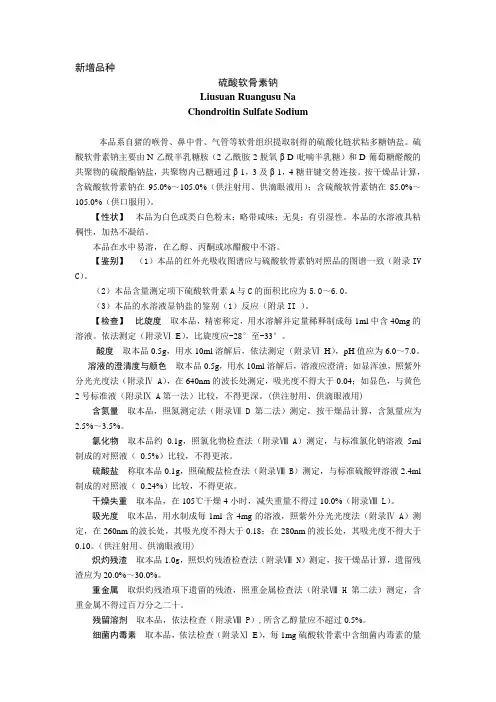
新增品种硫酸软骨素钠Liusuan Ruangusu NaChondroitin Sulfate Sodium本品系自猪的喉骨、鼻中骨、气管等软骨组织提取制得的硫酸化链状粘多糖钠盐。
硫酸软骨素钠主要由N-乙酰半乳糖胺(2-乙酰胺-2脱氧-β-D-吡喃半乳糖)和D-葡萄糖醛酸的共聚物的硫酸酯钠盐,共聚物内己糖通过β-1,3及β-1,4糖苷键交替连接。
按干燥品计算,含硫酸软骨素钠在95.0%~105.0%(供注射用、供滴眼液用);含硫酸软骨素钠在85.0%~105.0%(供口服用)。
【性状】本品为白色或类白色粉末;略带咸味;无臭;有引湿性。
本品的水溶液具粘稠性,加热不凝结。
本品在水中易溶,在乙醇、丙酮或冰醋酸中不溶。
【鉴别】(1)本品的红外光吸收图谱应与硫酸软骨素钠对照品的图谱一致(附录IV C)。
(2)本品含量测定项下硫酸软骨素A与C的面积比应为5.0~6.0。
(3)本品的水溶液显钠盐的鉴别(1)反应(附录II )。
【检查】比旋度取本品,精密称定,用水溶解并定量稀释制成每1ml中含40mg的溶液。
依法测定(附录ⅥE),比旋度应-28°至-33°。
酸度取本品0.5g,用水10ml溶解后,依法测定(附录ⅥH),pH值应为6.0~7.0。
溶液的澄清度与颜色取本品0.5g,用水10ml溶解后,溶液应澄清;如显浑浊,照紫外分光光度法(附录Ⅳ A),在640nm的波长处测定,吸光度不得大于0.04;如显色,与黄色2号标准液(附录Ⅸ A第一法)比较,不得更深。
(供注射用、供滴眼液用) 含氮量取本品,照氮测定法(附录Ⅶ D第二法)测定,按干燥品计算,含氮量应为2.5%~3.5%。
氯化物取本品约0.1g,照氯化物检查法(附录ⅧA)测定,与标准氯化钠溶液5ml 制成的对照液(0.5%)比较,不得更浓。
硫酸盐称取本品0.1g,照硫酸盐检查法(附录ⅧB)测定,与标准硫酸钾溶液2.4ml 制成的对照液(0.24%)比较,不得更浓。
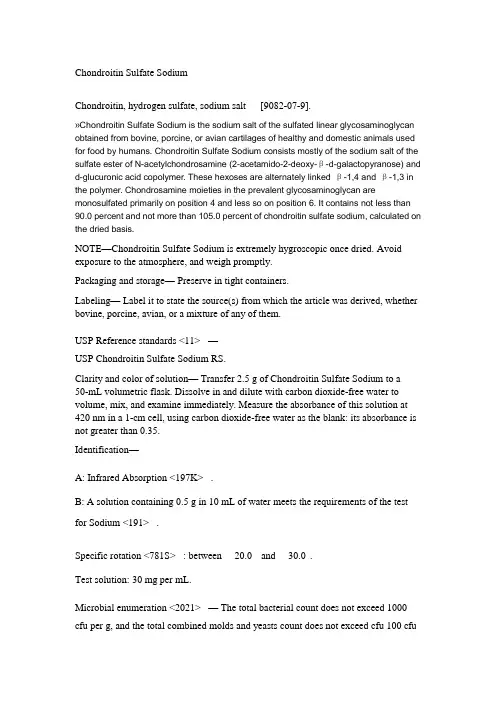
Chondroitin Sulfate SodiumChondroitin, hydrogen sulfate, sodium salt [9082-07-9].»Chondroitin Sulfate Sodium is the sodium salt of the sulfated linear glycosaminoglycan obtained from bovine, porcine, or avian cartilages of healthy and domestic animals used for food by humans. Chondroitin Sulfate Sodium consists mostly of the sodium salt of the sulfate ester of N-acetylchondrosamine (2-acetamido-2-deoxy-β-d-galactopyranose) and d-glucuronic acid copolymer. These hexoses are alternately linked β-1,4 and β-1,3 in the polymer. Chondrosamine moieties in the prevalent glycosaminoglycan are monosulfated primarily on position 4 and less so on position 6. It contains not less than 90.0 percent and not more than 105.0 percent of chondroitin sulfate sodium, calculated on the dried basis.NOTE—Chondroitin Sulfate Sodium is extremely hygroscopic once dried. Avoid exposure to the atmosphere, and weigh promptly.Packaging and storage— Preserve in tight containers.Labeling— Label it to state the source(s) from which the article was derived, whether bovine, porcine, avian, or a mixture of any of them.USP Reference standards <11>—USP Chondroitin Sulfate Sodium RS.Clarity and color of solution— Transfer 2.5 g of Chondroitin Sulfate Sodium to a50-mL volumetric flask. Dissolve in and dilute with carbon dioxide-free water to volume, mix, and examine immediately. Measure the absorbance of this solution at 420 nm in a 1-cm cell, using carbon dioxide-free water as the blank: its absorbance is not greater than 0.35.Identification—A: Infrared Absorption <197K>.B: A solution containing 0.5 g in 10 mL of water meets the requirements of the testfor Sodium <191>.Specific rotation <781S>: between 20.0and 30.0.Test solution: 30 mg per mL.Microbial enumeration <2021>— The total bacterial count does not exceed 1000 cfu per g, and the total combined molds and yeasts count does not exceed cfu 100 cfuper g. It meets the requirements of the tests for absence of Salmonella species, and Escherichia coli.pH <791>: between 5.5 and 7.5, in a solution (1 in 100).Loss on drying <731>— Dry it at 105for 4 hours: it loses not more than 10.0% of its weight. [note—Chondroitin Sulfate Sodium is extremely hygroscopic once dried. Avoid exposure to the atmosphere, and weigh promptly.]Residue on ignition <281>: between 20.0% and 30.0%, on the dried basis.Chloride <221>— A 0.10-g portion shows no more chloride than corresponds to 0.7 mL of 0.020 N hydrochloric acid: not more than 0.50% is found.Sulfate <221>— Dissolve 200 mg in 40 mL of water. Add 10 mL of a solution of cetylpyridinium chloride having a concentration of about 30 mg per mL, mix, and pass through a filter. A 25-mL portion of the filtrate shows no more sulfate than corresponds to 0.25 mL of 0.020 N sulfuric acid: not more than 0.24% is found.Heavy metals, Method II <231>: 0.002%.Electrophoretic purity (see Electrophoresis <726>)—0.1 M Barium acetate buffer, pH 5.0— Dissolve about 25.24 g of barium acetate in water, and dilute with water to 900 mL. Adjust with acetic acid to a pH of 5.0, dilute with water to 1 L, and mix.Staining reagent: 0.1% toluidine blue in acetic acid; dissolve 1 g of toluidine blue in 1000 mL of 0.1 M acetic acid.Standard solution 1— Prepare a solution of USP Chondroitin Sulfate Sodium RS in water having a known concentration of about 30 mg per mL.Standard solution 2— Dilute 1 mL of Standard solution 1 with water to 50 mL, and mix.Test solution— Transfer 150 mg of Chondroitin Sulfate Sodium, accurately weighed, to a 5.0-mL volumetric flask, dissolve in and dilute with water to volume, and mix. Procedure— Fill the chambers of an electrophoresis apparatus suitable for separations on cellulose acetate membranes1 (a small submarine gel chamber or one dedicated to membrane media) with 0.1 M Barium acetate buffer, pH 5.0. Soak a cellulose acetate membrane about 5 to 6 cm × 12 to 14 cm in 0.1 M Barium acetate buffer, pH 5.0 for 10 minutes, or until evenly wetted, then blot dry between two sheets of absorbentpaper. Using an applicator2 suitable for electrophoresis, apply equal volumes (about 0.5 µL) of the Test solution, Standard solution 1, and Standard solution 2 to the brighter side of the membrane held in position in an appropriate applicator stand or on a separating bridge in the chamber. Ensure that both ends of the membrane are dipped at least 0.5- to 1.0-cm deep into the buffer chambers. Apply a constant 60 volts (about 6 mA at the start) for 2 hours. [note—Perform the application of solutions and voltage within 5 minutes because further drying of the blotted paper reduces sensitivity.] Place the membrane in a plastic staining tray, and with the application side down, float or gently immerse in Staining reagent for 5 minutes. Then stir the solution gently for 1 minute. Remove the membrane, and destain in 5% acetic acid until the background clears. Compare the bands. The electropherogram obtained from the Test solution exhibits a major band that is identical in position to the band obtained from Standard solution 1. The band obtained from Standard solution 2 is clearly visible at a mobility similar to the band obtained from Standard solution 1. Any secondary band in the electropherogram of the Test solution is not more intense than the band obtained from Standard solution 2. Not more than 2% of any individual impurity is found. Document the results by taking a picture within 15 minutes of completion of destaining.Limit of protein—Alkaline cupric tartaric reagent— Dissolve 200 mg of sodium tartrate dihydrate in 10 mL of water, and mark as Solution A. Dissolve 100 mg of cupric sulfate in 10 mL of water, and mark as Solution B. Dissolve 2.0 g of anhydrous sodium carbonate in 0.1 M sodium hydroxide, dilute with 0.1 M sodium hydroxide to 100 mL, and mark as Solution C. Mix well 1 mL of Solution A and 1 mL of Solution B, and to the mixture slowly add 100 mL of Solution C with stirring. Use within 24 hours, and discard afterwards.Standard solution— Transfer an accurately measured volume of 7 percent bovine serum albumin certified standard to a suitable container, and dilute quantitatively and stepwise with water to obtain a solution having a known concentration of about 35 µg per mL.Test solution— Transfer an accurately weighed quantity of Chondroitin Sulfate Sodium, equivalent to 60 mg of the dried substance, to a 100-mL volumetric flask, dissolve in and dilute with water to volume, and mix.Procedure— Add 2.0 mL of freshly prepared Alkaline cupric tartaric reagent to test tubes containing 2.0 mL of water, 2.0 mL of the Test solution, or 2.0 mL of the Standard solution, and mix. After about 10 minutes, add 1.0 mL of Folin-Ciocalteu phenol TS, diluted with water (1:5) and prepared immediately before use, to each test tube, and mix immediately and vigorously. After 30 minutes, measure the absorbance of each solution at 750 nm against the blank. The absorbance of the Test solution is not greater than the absorbance of the Standard solution: not more than 6.0% of proteins is found, calculated on the dried basis.Content of chondroitin sulfate sodium—Cetylpyridinium chloride solution— Prepare a solution of cetylpyridinium chloride in water having a concentration of about 1 mg per mL. Degas before use.Diluent— Weigh about 297 mg of monobasic potassium phosphate, 492 mg of dibasic potassium phosphate, and 250 mg of polysorbate 80, and transfer into a 1-L beaker. Dissolve in 1000 mL of water, and adjust with potassium hydroxide or phosphoric acid to a pH of 7.0 ± 0.2.Standard solutions— Prepare a solution having a known concentration of USP Chondroitin Sulfate Sodium RS in water, and dilute with water, quantitatively and stepwise if necessary, to obtain three Standard solutions having known concentrations of about 1.5 mg per mL, 1.0 mg per mL, and 0.5 mg per mL, respectively.Test solution— Transfer about 100 mg of dried Chondroitin Sulfate Sodium, accurately weighed, to a 100-mL volumetric flask, dissolve in 30 mL of water, dilute with water to volume, and mix.Procedure— Transfer 5.0 mL of each Standard solution and the Test solution to four separate titration vessels, and add about 25 mL of Diluent. Use a phototrode to determine the endpoint turbidimetrically, either at 420 nm, 550 nm, or 660 nm. Stir until a steady reading is obtained. Set the instrument to zero in absorbance mode. Titrate with Cetylpyridinium chloride solution. From a linear regression equation derived from the volumes of Cetylpyridinium chloride solution consumed, and the masses, in mg, of USP Chondroitin Sulfate Sodium RS in the aliquots of the respective Standard solutions, determine the mass of chondroitin sulfate sodium in the aliquot of the Test solution taken. Calculate the percentage of chondroitin sulfate sodium in the portion taken by the formula:2000(M/W)in which M is the mass of Chondroitin Sulfate Sodium found in the aliquot of the Test solution; and W is the weight, in mg, of Chondroitin Sulfate Sodium taken to prepare the Test solution.1 Suitable cellulose acetate membranes for electrophoresis are available from Malta Chemetron SRL, Milano, Italy (); Fluka Chemical Corp., Milwaukee, WI; and DiaSys Corp., Waterbury, CT ().2 Suitable applications are available from DiaSys Corp., Waterbury, CT(); and Helena Laboratories, Beaumont, TX (). Auxiliary Information— Please check for your question in the FAQs before contacting USP.USP32–NF27 Page 980Pharmacopeial Forum: Volume No. 30(6) Page 2068。
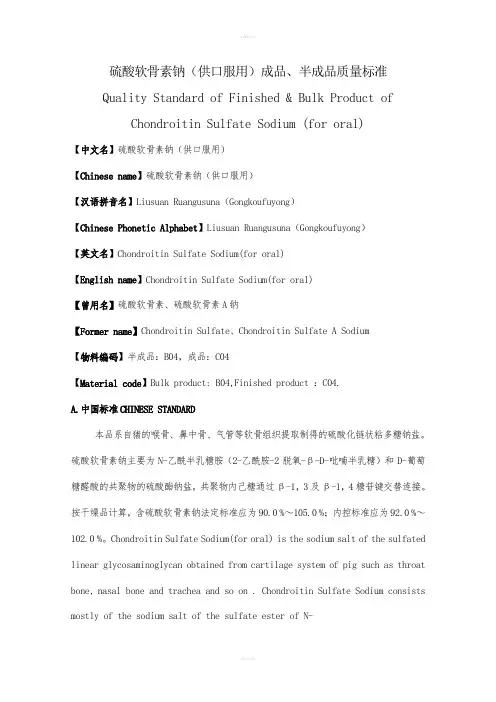
硫酸软骨素钠(供口服用)成品、半成品质量标准Quality Standard of Finished & Bulk Product ofChondroitin Sulfate Sodium (for oral)【中文名】硫酸软骨素钠(供口服用)【Chinese name】硫酸软骨素钠(供口服用)【汉语拼音名】Liusuan Ruangusuna(Gongkoufuyong)【Chinese Phonetic Alphabet】Liusuan Ruangusuna(Gongkoufuyong)【英文名】Chondroitin Sulfate Sodium(for oral)【English name】Chondroitin Sulfate Sodium(for oral)【曾用名】硫酸软骨素、硫酸软骨素A钠【Former name】Chondroitin Sulfate、Chondroitin Sulfate A Sodium【物料编码】半成品:B04,成品:C04【Material code】Bulk product: B04,Finished product :C04.A.中国标准CHINESE STANDARD本品系自猪的喉骨、鼻中骨、气管等软骨组织提取制得的硫酸化链状粘多糖钠盐。
硫酸软骨素钠主要为N-乙酰半乳糖胺(2-乙酰胺-2脱氧-β-D-吡喃半乳糖)和D-葡萄糖醛酸的共聚物的硫酸酯钠盐,共聚物内己糖通过β-1,3及β-1,4糖苷键交替连接。
按干燥品计算,含硫酸软骨素钠法定标准应为90.0 %~105.0 %;内控标准应为92.0 %~102.0 %。
Chondroitin Sulfate Sodium(for oral) is the sodium salt of the sulfated linear glycosaminoglycan obtained from cartilage system of pig such as throat bone,nasal bone and trachea and so on . Chondroitin Sulfate Sodium consists mostly of the sodium salt of the sulfate ester of N-acetylchondrosamine (2-acetamido-2-deoxy-β-D- galactopyranose) and D-glucuronic acid copolymer. These hexoses are alternately linked β-1, 4 and β-1, 3 in the polymer. Calculated on the dried basis, the official standard is 90.0 %~105.0 %of chondroitin sulfate sodium, the internal standard is 92.0 %~102.0 % of chondroitin sulfate sodium.【性状】CHARACTERS本品为白色或类白色粉末;略带咸味;无臭;有引湿性。
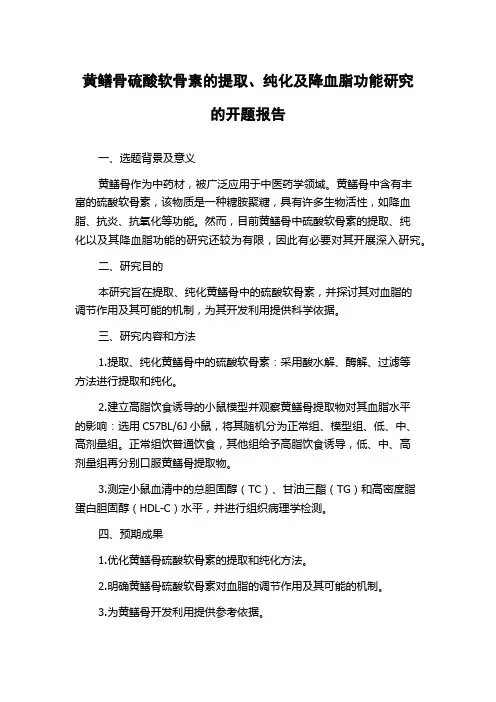
黄鳝骨硫酸软骨素的提取、纯化及降血脂功能研究的开题报告一、选题背景及意义黄鳝骨作为中药材,被广泛应用于中医药学领域。
黄鳝骨中含有丰富的硫酸软骨素,该物质是一种糖胺聚糖,具有许多生物活性,如降血脂、抗炎、抗氧化等功能。
然而,目前黄鳝骨中硫酸软骨素的提取、纯化以及其降血脂功能的研究还较为有限,因此有必要对其开展深入研究。
二、研究目的本研究旨在提取、纯化黄鳝骨中的硫酸软骨素,并探讨其对血脂的调节作用及其可能的机制,为其开发利用提供科学依据。
三、研究内容和方法1.提取、纯化黄鳝骨中的硫酸软骨素:采用酸水解、酶解、过滤等方法进行提取和纯化。
2.建立高脂饮食诱导的小鼠模型并观察黄鳝骨提取物对其血脂水平的影响:选用C57BL/6J小鼠,将其随机分为正常组、模型组、低、中、高剂量组。
正常组饮普通饮食,其他组给予高脂饮食诱导,低、中、高剂量组再分别口服黄鳝骨提取物。
3.测定小鼠血清中的总胆固醇(TC)、甘油三酯(TG)和高密度脂蛋白胆固醇(HDL-C)水平,并进行组织病理学检测。
四、预期成果1.优化黄鳝骨硫酸软骨素的提取和纯化方法。
2.明确黄鳝骨硫酸软骨素对血脂的调节作用及其可能的机制。
3.为黄鳝骨开发利用提供参考依据。
五、研究进度安排第一年:完成黄鳝骨中硫酸软骨素的提取、纯化、检测等方法的建立;第二年:建立小鼠高脂饮食诱导模型,进行黄鳝骨提取物调节血脂的实验;第三年:进一步探讨黄鳝骨提取物的机制并阐明可能的调节途径,撰写论文。
六、参考文献1. 姜岳伟,等.黄鳝骨抗氧化及抗炎作用研究,黑龙江畜牧兽医,2013,(22):107-108.2. 孙庆领,等.中国黄鳝鱼指南.北京:化学工业出版社,2016.3. 刘远珠,等.硫酸软骨素的药理及临床应用现状,中国药理学通报,2011,(8):1010-1014.。
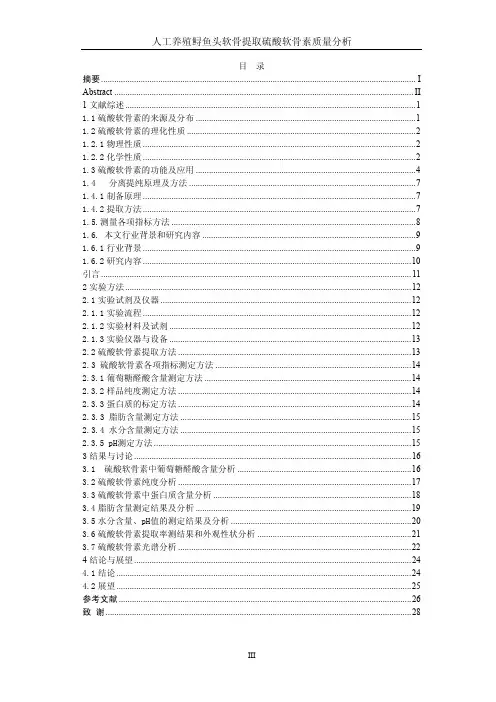
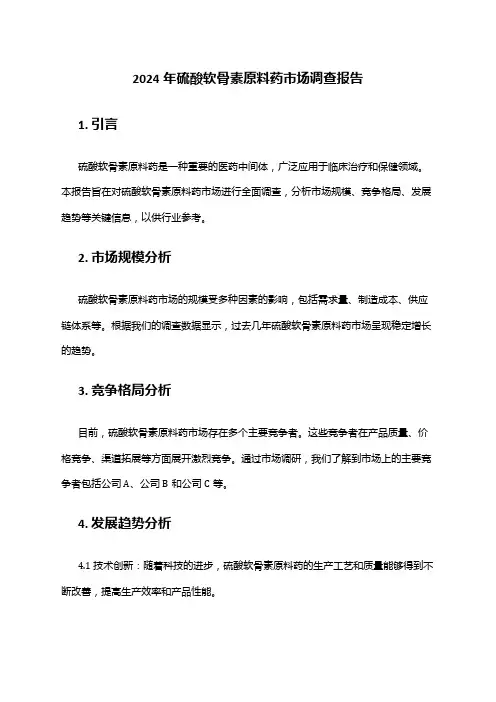
2024年硫酸软骨素原料药市场调查报告
1. 引言
硫酸软骨素原料药是一种重要的医药中间体,广泛应用于临床治疗和保健领域。
本报告旨在对硫酸软骨素原料药市场进行全面调查,分析市场规模、竞争格局、发展趋势等关键信息,以供行业参考。
2. 市场规模分析
硫酸软骨素原料药市场的规模受多种因素的影响,包括需求量、制造成本、供应链体系等。
根据我们的调查数据显示,过去几年硫酸软骨素原料药市场呈现稳定增长的趋势。
3. 竞争格局分析
目前,硫酸软骨素原料药市场存在多个主要竞争者。
这些竞争者在产品质量、价格竞争、渠道拓展等方面展开激烈竞争。
通过市场调研,我们了解到市场上的主要竞争者包括公司A、公司B和公司C等。
4. 发展趋势分析
4.1 技术创新:随着科技的进步,硫酸软骨素原料药的生产工艺和质量能够得到不断改善,提高生产效率和产品性能。
4.2 健康保健行业需求增长:人们对健康的关注不断增加,硫酸软骨素原料药作为保健品的应用领域有望继续增长。
4.3 新兴市场潜力:随着亚洲和拉丁美洲市场的开拓,硫酸软骨素原料药的需求量有望出现显著增长。
5. 市场前景展望
硫酸软骨素原料药市场具有稳定增长的趋势,预计未来几年市场需求将持续增长。
同时,随着技术创新和新兴市场的开发,市场竞争将加剧。
因此,企业应重视产品质量和服务水平提升,同时寻找新的增长点和市场机会。
6. 结论
硫酸软骨素原料药市场作为一个重要的医药中间体市场,具有广阔的发展前景。
企业应密切关注市场变化,积极应对竞争挑战,并寻求新的市场机会,以保持市场竞争力和可持续发展。
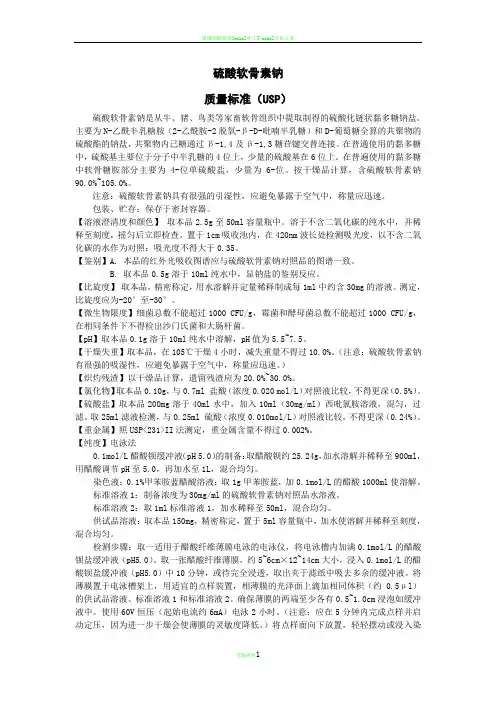
硫酸软骨素钠质量标准(USP)硫酸软骨素钠是从牛、猪、鸟类等家畜软骨组织中提取制得的硫酸化链状黏多糖钠盐。
主要为N-乙酰半乳糖胺(2-乙酰胺-2脱氧-β-D-吡喃半乳糖)和D-葡萄糖全算的共聚物的硫酸酯的钠盐,共聚物内己糖通过β-1,4及β-1,3糖苷键交替连接。
在普通使用的黏多糖中,硫酸基主要位于分子中半乳糖的4位上,少量的硫酸基在6位上。
在普遍使用的黏多糖中软骨糖胺部分主要为4-位单硫酸盐,少量为6-位。
按干燥品计算,含硫酸软骨素钠90.0%~105.0%。
注意:硫酸软骨素钠具有很强的引湿性,应避免暴露于空气中,称量应迅速。
包装、贮存:保存于密封容器。
【溶液澄清度和颜色】取本品2.5g至50ml容量瓶中。
溶于不含二氧化碳的纯水中,并稀释至刻度,摇匀后立即检查。
置于1cm吸收池内,在420nm波长处检测吸光度,以不含二氧化碳的水作为对照:吸光度不得大于0.35。
【鉴别】A. 本品的红外光吸收图谱应与硫酸软骨素钠对照品的图谱一致。
B. 取本品0.5g溶于10ml纯水中,显钠盐的鉴别反应。
【比旋度】取本品,精密称定,用水溶解并定量稀释制成每1ml中约含30mg的溶液。
测定,比旋度应为-20°至-30°。
【微生物限度】细菌总数不能超过1000 CFU/g,霉菌和酵母菌总数不能超过1000 CFU/g,在相同条件下不得检出沙门氏菌和大肠杆菌。
【pH】取本品0.1g溶于10ml纯水中溶解,pH值为5.5~7.5。
【干燥失重】取本品,在105℃干燥4小时,减失重量不得过10.0%。
(注意:硫酸软骨素钠有很强的吸湿性,应避免暴露于空气中,称量应迅速。
)【炽灼残渣】以干燥品计算,遗留残渣应为20.0%~30.0%。
【氯化物】取本品0.10g,与0.7ml 盐酸(浓度0.020 mol/L)对照液比较,不得更深(0.5%)。
【硫酸盐】取本品200mg溶于40ml水中,加入10ml(30mg/ml)西吡氯胺溶液,混匀,过滤。
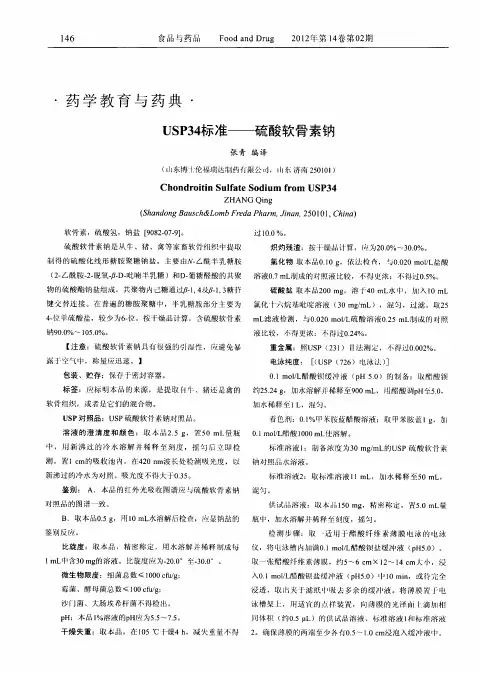
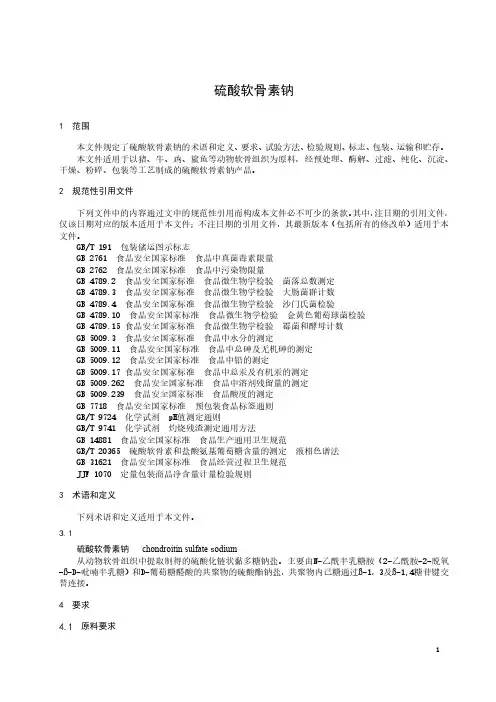
硫酸软骨素钠1范围本文件规定了硫酸软骨素钠的术语和定义、要求、试验方法、检验规则、标志、包装、运输和贮存。
本文件适用于以猪、牛、鸡、鲨鱼等动物软骨组织为原料,经预处理、酶解、过滤、纯化、沉淀、干燥、粉碎、包装等工艺制成的硫酸软骨素钠产品。
2规范性引用文件下列文件中的内容通过文中的规范性引用而构成本文件必不可少的条款。
其中,注日期的引用文件,仅该日期对应的版本适用于本文件;不注日期的引用文件,其最新版本(包括所有的修改单)适用于本文件。
GB/T 191 包装储运图示标志GB 2761 食品安全国家标准食品中真菌毒素限量GB 2762 食品安全国家标准食品中污染物限量GB 4789.2 食品安全国家标准食品微生物学检验菌落总数测定GB 4789.3 食品安全国家标准食品微生物学检验大肠菌群计数GB 4789.4食品安全国家标准食品微生物学检验沙门氏菌检验GB 4789.10 食品安全国家标准食品微生物学检验金黄色葡萄球菌检验GB 4789.15 食品安全国家标准食品微生物学检验霉菌和酵母计数GB 5009.3食品安全国家标准食品中水分的测定GB 5009.11 食品安全国家标准食品中总砷及无机砷的测定GB 5009.12 食品安全国家标准食品中铅的测定GB 5009.17 食品安全国家标准食品中总汞及有机汞的测定GB 5009.262 食品安全国家标准食品中溶剂残留量的测定GB 5009.239食品安全国家标准食品酸度的测定GB 7718 食品安全国家标准预包装食品标签通则GB/T 9724 化学试剂pH值测定通则GB/T 9741 化学试剂灼烧残渣测定通用方法GB 14881 食品安全国家标准食品生产通用卫生规范GB/T 20365硫酸软骨素和盐酸氨基葡萄糖含量的测定液相色谱法GB 31621 食品安全国家标准食品经营过程卫生规范JJF 1070 定量包装商品净含量计量检验规则3术语和定义下列术语和定义适用于本文件。
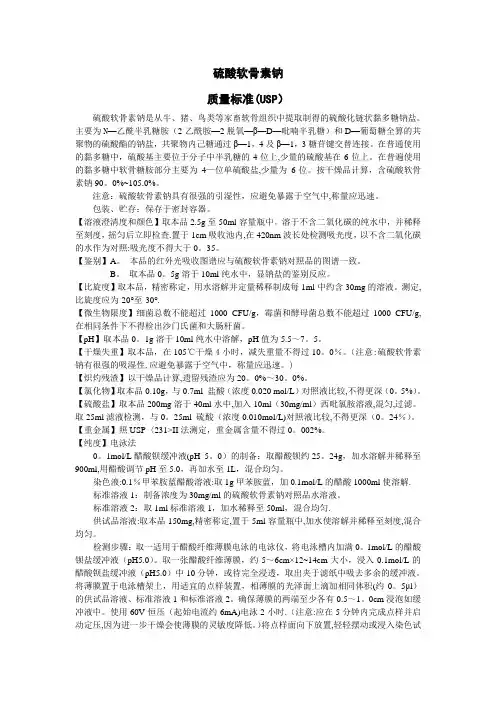
硫酸软骨素钠质量标准(USP)硫酸软骨素钠是从牛、猪、鸟类等家畜软骨组织中提取制得的硫酸化链状黏多糖钠盐。
主要为N—乙酰半乳糖胺(2-乙酰胺—2脱氧—β—D—吡喃半乳糖)和D—葡萄糖全算的共聚物的硫酸酯的钠盐,共聚物内己糖通过β—1,4及β—1,3糖苷键交替连接。
在普通使用的黏多糖中,硫酸基主要位于分子中半乳糖的4位上,少量的硫酸基在6位上。
在普遍使用的黏多糖中软骨糖胺部分主要为4—位单硫酸盐,少量为6-位。
按干燥品计算,含硫酸软骨素钠90。
0%~105.0%。
注意:硫酸软骨素钠具有很强的引湿性,应避免暴露于空气中,称量应迅速。
包装、贮存:保存于密封容器。
【溶液澄清度和颜色】取本品2.5g至50ml容量瓶中。
溶于不含二氧化碳的纯水中,并稀释至刻度,摇匀后立即检查.置于1cm吸收池内,在420nm波长处检测吸光度,以不含二氧化碳的水作为对照:吸光度不得大于0。
35。
【鉴别】A。
本品的红外光吸收图谱应与硫酸软骨素钠对照品的图谱一致。
B。
取本品0。
5g溶于10ml纯水中,显钠盐的鉴别反应。
【比旋度】取本品,精密称定,用水溶解并定量稀释制成每1ml中约含30mg的溶液。
测定,比旋度应为-20°至-30°.【微生物限度】细菌总数不能超过1000 CFU/g,霉菌和酵母菌总数不能超过1000 CFU/g,在相同条件下不得检出沙门氏菌和大肠杆菌。
【pH】取本品0。
1g溶于10ml纯水中溶解,pH值为5.5~7。
5。
【干燥失重】取本品,在105℃干燥4小时,减失重量不得过10。
0%。
(注意:硫酸软骨素钠有很强的吸湿性,应避免暴露于空气中,称量应迅速。
)【炽灼残渣】以干燥品计算,遗留残渣应为20。
0%~30。
0%。
【氯化物】取本品0.10g,与0.7ml 盐酸(浓度0.020 mol/L)对照液比较,不得更深(0。
5%)。
【硫酸盐】取本品200mg溶于40ml水中,加入10ml(30mg/ml)西吡氯胺溶液,混匀,过滤。
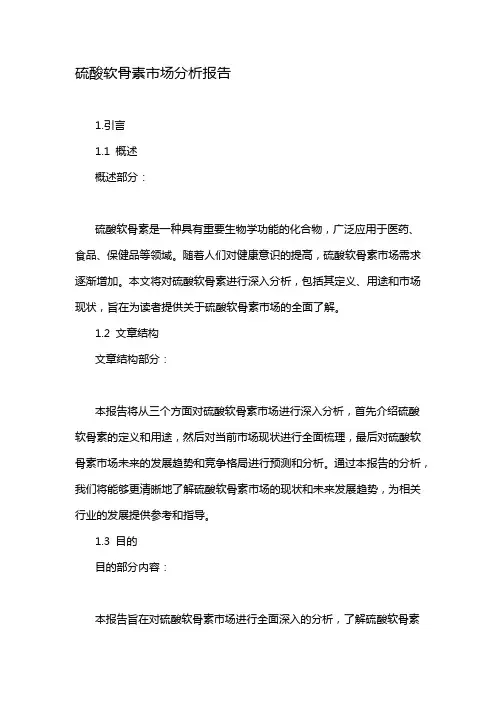
硫酸软骨素市场分析报告1.引言1.1 概述概述部分:硫酸软骨素是一种具有重要生物学功能的化合物,广泛应用于医药、食品、保健品等领域。
随着人们对健康意识的提高,硫酸软骨素市场需求逐渐增加。
本文将对硫酸软骨素进行深入分析,包括其定义、用途和市场现状,旨在为读者提供关于硫酸软骨素市场的全面了解。
1.2 文章结构文章结构部分:本报告将从三个方面对硫酸软骨素市场进行深入分析,首先介绍硫酸软骨素的定义和用途,然后对当前市场现状进行全面梳理,最后对硫酸软骨素市场未来的发展趋势和竞争格局进行预测和分析。
通过本报告的分析,我们将能够更清晰地了解硫酸软骨素市场的现状和未来发展趋势,为相关行业的发展提供参考和指导。
1.3 目的目的部分内容:本报告旨在对硫酸软骨素市场进行全面深入的分析,了解硫酸软骨素的定义、用途以及市场现状。
同时,通过对市场发展趋势和竞争格局的分析,为投资者和行业相关人士提供有益的市场参考,帮助他们更好地把握市场机会,做出明智的决策。
通过本报告的撰写,我们将为读者呈现一个清晰的硫酸软骨素市场画面,为行业发展提供有力支持。
1.4 总结综上所述,硫酸软骨素作为一种重要的生物活性物质,在医药、保健品、食品等领域都有着广泛的应用。
目前市场需求持续增长,市场规模不断扩大,行业竞争也日益激烈。
随着健康意识的增强和人们对保健品需求的提升,硫酸软骨素市场有望迎来更大的发展机遇。
同时,硫酸软骨素行业也面临着产品质量、安全性、创新等方面的挑战。
未来,硫酸软骨素市场也需要不断创新和提高产业链水平,以满足消费者的多样化需求,实现可持续发展。
2.正文2.1 硫酸软骨素的定义"硫酸软骨素是一种由软骨组织提取的天然多糖类化合物,在医药和保健品行业中被广泛应用。
它是软骨组织中重要的成分之一,具有良好的生物相容性和生物活性。
硫酸软骨素具有一定的抗炎、抗氧化和保护关节软骨的作用,因此被广泛用于治疗关节炎、软骨损伤和其他关节疾病。
硫酸软骨素片的研发报告姓名:陈伟伟班级:B食品102 学号:1010308217 得分:________1.产品立项的目的与依据硫酸软骨素(CS)是共价连接在蛋白质上形成蛋白聚糖的一类糖胺聚糖。
硫酸软骨素广泛分布于动物组织的细胞外基质和细胞表面,糖链由交替的葡萄糖醛酸和N-乙酰半乳糖胺(又称N-乙酰氨基半乳糖)二糖单位组成,通过一个似糖链街区连接到核心蛋白质丝氨酸残基上。
硫酸软骨素存在于从线虫到人除植物外的所有生物中,发挥着许多重要的生理功能。
虽然多糖的主链结构并不复杂,但就硫酸化程度、硫酸基和两种差异向异构糖醛酸再链内的分布来说,呈现高度的不均一性。
硫酸软骨素的精细结构决定着功能的特异性和与多种蛋白质分子的相互作用。
1.1.国内外发展应用动态在欧洲许多国家硫酸软骨素作为处方或非处方药物使用,而在美国则是作为膳食补充剂使用。
在澳大利亚,硫酸软骨素属于营养保健品。
澳大利亚市场上常见的硫酸软骨素产品为用于骨关节炎防治的药品,大多与葡糖胺制成复合制剂。
不同商品名的产品,种类繁多,其成分大同小异,硫酸软骨素与葡糖胺的比例有所不同,有些产品还添加了甲磺酰甲烷(MSM,有机硫)、钙、镁、锌、锰、铜等元素或抗坏血酸等抗氧化剂,以期提高疗效。
在营养品商店可见到澳大利亚生产的和进口的硫酸软骨素制剂,例如美国GNC 的鲨鱼软骨片,其主要成分为硫酸软骨。
此外,还有硫酸软骨素与透明质酸的复合制剂,用于眼科晶状体置换手术。
1.2.产品预期达到的保健功能产品预期达到的保健功能有:增强免疫功能;预防动脉粥样硬化的功能;降低血脂的功能;抗关节炎作用的功能;促进细胞增生的功能;抗凝血作用的功能;抗肿瘤的功能。
1.3.产品特点1.3.1.营养高1.3.2.符合现代人需求特点1.3.3.健康安全1.4.工艺路线保障措施硫酸软骨素片的制作工艺复杂,采用了双酶生产工艺和中空纤维超滤等现代技术,使质量稳定和得率提高,只要掌握好这些技术要点,就能生产出合格的产品。
硫酸软骨素1范围本标准规定了硫酸软骨素的技术要求、试验方法、检验规则、标志、包装、运输及贮存。
本标准适用于以牛软骨为原料,经精拣、清洗、食用盐水煮料,碳酸钠碱解,盐酸中和、木瓜酶水解,盐酸凝固蛋白,再经过滤、超滤、酒精沉淀、喷雾干燥、包装等工序制成的食品原料硫酸软骨素。
2规范性引用文件下列文件对于本文件的应用是必不可少的。
凡是注日期的引用文件,仅注日期的版本适用于本标准。
凡是不注日期的引用文件,其最新版本(包括所有的修改单)适用于本文件。
GB/T 191 包装储运图示标志GB 1886.1 食品安全国家标准食品添加剂碳酸钠GB 1886.9 食品安全国家标准食品添加剂盐酸GB 1886.174 食品安全国家标准食品添加剂食品工业用酶制剂GB 2707 食品安全国家标准鲜(冻)畜、禽产品GB 2760 食品安全国家标准食品添加剂使用标准GB 2762 食品安全国家标准食品中污染物限量GB 4789.2 食品安全国家标准食品微生物学检验菌落总数测定GB 4789.3 食品安全国家标准食品微生物学检验大肠菌群计数GB 4789.4 食品安全国家标准食品微生物学检验沙门氏菌检验GB 4789.10 食品安全国家标准食品微生物学检验金黄色葡萄球菌检验GB 4806.7 食品安全国家标准食品接触用塑料材料及制品GB 5009.3 食品安全国家标准食品中水分的测定GB 5009.4 食品安全国家标准食品中灰分的测定GB 5009.11 食品安全国家标准食品中总砷及无机砷的测定GB 5009.12 食品安全国家标准食品中铅的测定GB 5009.15 食品安全国家标准食品中镉的测定GB 5009.17 食品安全国家标准食品中总汞及有机汞的测定GB 5009.44 食品安全国家标准食品中氯化物的测定GB 5009.123 食品安全国家标准食品中铬的测定GB 5009.237 食品安全国家标准食品pH值的测定GB/T 5461 食用盐GB 7718 食品安全国家标准预包装食品标签通则GB 14881 食品安全国家标准食品生产通用卫生规范GB/T 20365 硫酸软骨素和盐酸氨基葡萄糖含量的测定液相色谱法GB 31640 食品安全国家标准食用酒精SN/T 3636 出口食品中硫酸盐的测定离子色谱法JJF 1070 定量包装商品净含量计量检验规则国家质量监督检验检疫总局令第75号《定量包装商品计量监督管理办法》国家质量监督检验检疫总局令第123号《食品标识管理规定》3 技术要求3.1 原料和辅料要求3.1.1 原料牛软骨:应符合GB 2707的规定。
硫酸软骨素检测报告
项目 说明 检测结果
外观 白色粉末 通过
识别 红外证实 通过
钠反应 证实
定量分析 大于90% 90.50%
干燥损失 小于10% 8.90%
蛋白质 NMT6.0% 通过
重金属 NMT20PPM 通过
pH(1%水溶液) 5.5-7.5 6.5
旋光度 负20°-负30° 负28.9°
氯化物 NMT0.5% 通过
硫酸盐 NMT0.24% 通过
燃烧残渣 20%-30% 23.50%
透光度(5%水溶液) 420nm下,<0.35 0.21
有机挥发杂质 见实验 通过
电泳纯度 NMT2.0% 通过
总细菌数 <1000Col/g 通过
酵母和霉菌 <100Col/g 通过
沙门氏菌 阴性 通过
大肠杆菌 阴性 通过
盐酸葡萄糖胺
项目 标准 结果
外观 白色晶体粉末 白色晶体粉末
含量 >=99.0% 99.83%
干燥损失 <=0.2% 0.05%
旋光度 72+-1° 72.25°
燃烧残渣 <=0.1% 0.05%
pH 3.5-5.0 4.05%
重金属 <=10ppm <10ppm
铁 <=10ppm 1.23ppm
总细菌数 <1000CFU/g <500CFU/g
酵母和霉菌 <100CFU/g <20CFU/g
大肠杆菌 阴性 阴性
沙门氏菌 阴性 阴性